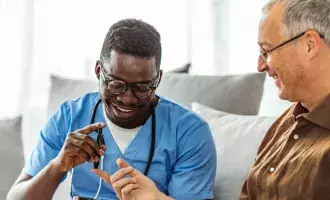The UK Government’s spending review in June committed a record £29 billion investment to get the NHS back on its feet and fit for the future. This included £10 billion ringfenced for investment in technology and digital.
In the same month, Health Minister Wes Streeting delivered a keynote speech at NHS Confed Expo, outlining ambitious and urgent plans for NHS reform over the next 10 years. The key takeaways included a focus on outcomes and enhancing population health, making tangible improvements to patient care and service efficiency. One overall guiding principle was clear: the patient is king.
At Capita, this vision is something we’ve been advocating for. It’s a once-in-a-generation opportunity to rethink how we deliver services differently – integrating health and social care, rebuilding the community and linking in all patients’ health touchpoints, and centralising patient data in a secure way. Our aim is to make pathways clearer and more accessible, delivering more successful outcomes.
And the way to achieve this is through collaboration.
This was the starting point for a roundtable that Capita recently hosted in partnership with the King’s Fund. The event brought together representatives from NHS care boards, pharmacies, insurance companies and private health providers, as well as medical technology and innovation experts. Uniquely, community providers were also present.
It was an open forum to explore some of the pain points, opportunities and obstacles in the delivery of services.
Where does it hurt?
The discussion identified multiple pain points in current service delivery.
Some shared a theme of disconnect – challenges in communication between professionals, broken patient pathways in and out of NHS and private services, and disjointed social care and health services, with providers not speaking each other’s languages and continuing to work in silos.
Innovation was another theme, but with a focus on what matters most to the patient. There is a need for a single source of data and consistent patient notes, while many fatigued patients and carers prefer virtual health management consultations or phone calls to travelling to appointments.
In terms of innovation, there was consensus that services of the future need to be built from the community – meaning social care, and primary and community care services – and be reflected back into secondary care, rather than beginning at the point of admission into secondary care, as is often the case currently.
Obstacles to progress in service innovation and quality
Preparation is key. Quite simply, if hospitals and clinicians aren’t ready for innovation, it’s unlikely to be adopted. This points to a wider consideration of how we ensure that services are adopted beyond a successful pilot - to achieve this means projecting scalability from an early planning phase beyond the minimum viable product or service.
There are also human factors at play. One ex-GP said: “I so believe in holistic healthcare, but we are part of the problem – we don’t always agree with each other and we think we should be in control. I fear that doctor-led services will fail.”
Conversely, where this GP had had the biggest success was by starting to rebuild the community – as Wes Streeting also suggested – relying more on others such as care navigators and ‘customer service’ staff (or receptionists).
Care navigators, in particular, are a fundamental part of any new service, bringing communication and visibility to all stakeholders – be they patient, private hospital, NHS, insurer, community pharmacy, or care providers such as agencies or nursing homes.
Similarly, patients are experiencing a knowledge gap with regards to access points and referral pathways, such as what services they can access, how and how quickly. This varies from region to region and is a barrier to continuity of care post-discharge. Likewise, data. The NHS is awash with it, but it’s not consumable across departments, analysed to predict outcomes, nor utilised to formulate care pathways. Everyone agreed a universal, condition-agnostic approach is needed.
Learning from success
However, delegates reported some wins. For children with congenital heart disease waiting for an operation, connecting heart rate monitors to consultants’ phones enabled early interventions and got children back to school.
Another attendee oversaw a project using data profiling to target individuals who are frequently in and out of hospital. A multidisciplinary team proactively contacts a patient if they are perceived to be at risk, and coordinates both clinical and social care input. This has demonstrated an 80% reduction of 999 and 111 calls and GP visits.
At Capita we’ve used our clinical capability in multiple projects: we have clinicians working on Armed Forces contracts including our Recruiting Partnering Project, and we’ve delivered medical record management and digitisation for the NHS and MoD, healthcare assessments as a service for DWP, and work with PCSE.
As a registered and practising nurse, I bring hands-on health and medical experience and subject matter expertise to the table but I also work in the private sector delivering clinical solution design and project management across defence, occupational health, private medical insurance, and community, primary and secondary care.
It’s our goal to support virtual management in all aspects of health and social care, and we believe there are several opportunities to achieve this.
Where could virtual management partnerships help?
We asked the roundtable delegates to suggest where they see opportunities, and the feedback was wide-ranging.
For example, holistic and preventative use of data. What do we know from a patient’s medical history that could inform HCPs and family? Rather than focusing on revenue per patient, could we home in on how many people we have waiting?
When it comes to rebuilding communities, how could we make use of touchpoints such as pharmacists, optometrists and community nurses? A central system or app to enable them to triage or report concerns about a patient would be incredibly useful. Linking to this, one delegate reported that 80% of data is observed but not documented – and only once it’s captured can we do something with it.
Overall, there were key considerations of how to help navigate new pathways. Restricted budgets and access because of wait lists will necessitate a ‘mix and match’ system, going in and out of the NHS according to need – private care is no longer viewed as a luxury.
Therefore, we need to put the navigation of that wider network in the hands of patients and align everyone for the patient’s benefit. It is already happening, as patients take their care into their own hands, self-serving and buying their own equipment and treatment, usually without clinical oversight. This is described as ‘technology-enabled independent living’ – but so far, the NHS has not been able to support this.
Everyone agreed the NHS can learn a great deal from health management app culture – people trust health apps because they’re easily accessible and beneficial to patient care.
Enabled by apps and the wide-ranging data they are recording, patients can decide for themselves what treatment to pursue. If the NHS were able to use its datasets, it could become the arbiter for health app development and a trusted, safe harbour for innovation.
Key questions and considerations
Everyone had a story about technology not delivering on its promise, or systems not being ready to adopt it. This raised some compelling questions.
For example, with virtual management, who are we trying to help? The highest-cost patient or the hardest to reach? Are we helping people get better so they can get back to work? How can we link services together end-to-end so that better education can drive higher life expectancy?
One attendee also observed that housebound patients vary massively in age – but they share a relatively low level of health literacy. So how can we enable patients to ask the right questions of their chosen healthcare provider? One delegate uses TikTok to explore health topics – how could we use new channels to influence and educate different communities?
Patients must be able to trust new innovations and see that they actually work. This means new digital services need to be tested and have built-in scalability from the outset.
And finally, perhaps the biggest question: how can we join up existing innovations?
Let’s explore this potential transformation together
Delegates agreed that a monolithic system is no longer the ideology for the NHS, and that patients may need to more actively steer their pathway with better signposting to a catalogue of services.
However, for multi-partner, mutual investment models to work in an end-to-end way requires some behaviours to be unlearned and some ceding of control by medical professionals, including GPs. This won’t be easy, and the concept will have to be proven before it can scale.
This is why we are inviting interested parties and partners to join a pilot.
If you’d like to explore a future model of healthcare delivery, we want to hear from you. Contact bettergovernment@capita.com.

Kathryn Phillips
Market development manager, Virtual health management, Capita
Kathryn is a highly experienced professional with a broad healthcare and corporate background. An NMC-registered nurse, she drives digital transformation in healthcare, improving outcomes for citizens and government. She previously contributed to Capita’s Armed Forces Recruitment Programme bid, shaping medical and wider recruitment solutions for the Royal Navy, the British Army and the Royal Air Force. Kathryn excels in clinical solution design, project management, and stakeholder collaboration across defence, occupational health, private medical insurance, and community, primary and secondary care.







